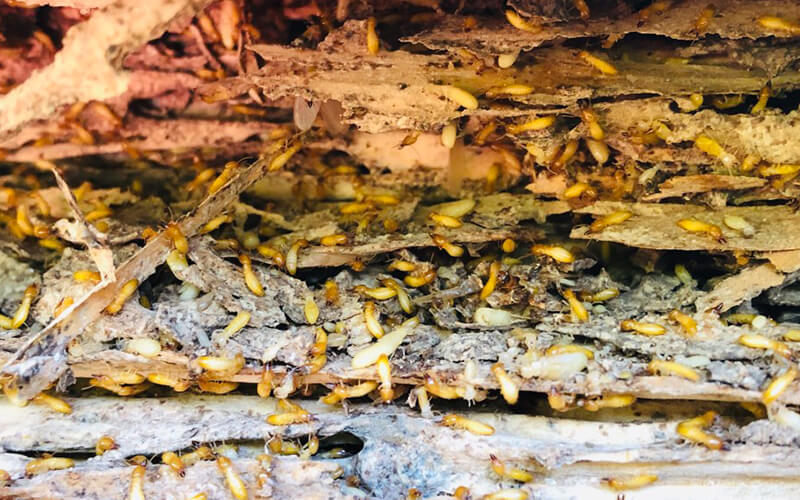Termite infestation could become a big problem in your home if left alone. They could pose structural damage to your foundation, walls, and furniture. Termites need food, moisture, and insulation to thrive and multiply, and crawlspaces are a perfect place to make their base with foundations as their gateway into your house.
Below are seven simple ways you could use to prevent an infestation of termites.
Never Let Moisture Collect Around The Foundation
Termites love moisture, and the more there are in the soil, the more attracted they would be. They thrive in a moisture-rich environment, and its presence near or around your foundation is an invitation to enter your home. Therefore, it is important to get rid of excess moisture to keep termites at bay.
Identifying possible sources of water is an excellent place to start in eliminating excess moisture. Grade or slope the ground around your property and foundations so that water drains away from them. Properly direct downspouts, gutters, and splash blocks to avoid water to pool. Repair leaking pipes, faucets, or air conditioning units that might add more moisture.
If you cannot avoid water from accumulating, make sure to install a proper drainage system. You could also use tiles around your property.
Have Proper Ventilation For Your Crawlspace Or Basement
Reducing moisture and humidity in areas around the foundation, such as your basement and crawlspace, is a great way to help prevent termites from invading your home. Properly ventilating these spaces would aid you greatly in the fight against termites.
Most building codes require one square foot of vent opening 150 square feet of crawlspace area with a vent within three feet of your house’s exterior corner. Ensure all vents are free of any obstruction such as debris, leaves, dirt, or vegetation. You could also install vapor barriers such as polyethylene sheeting over the soil to lessen evaporation from the soil.
Additionally, if you live in a humid environment, a dehumidifier would come in very handy.
If You Can Help It, Avoid Wood-Soil Contact
As wood is the number one food source for termites, direct contact with soil allows these pests to access your home easily. Termites could easily tunnel through wood, which loses its integrity over time. Combined with moisture, wood could quickly rot and encourage more termites to attack.
Eliminating wood-to-soil contact may require supporting posts or steps with a concrete base, pulling soil back from the foundation, or cutting or raising the bottom of wood sidings. If you decide to install wooden flower boxes, make sure not to let them touch foundation walls.
Keep Wood-based And Cellulose Firewood Away From Your Home
Never stockpile your firewood, lumber, or any cellulose product such as cardboard boxes against foundations or inside crawlspaces. Not only do these materials provide food for termites, but they could also provide safe and hidden entry to would-be invaders. Wood-based materials located around foundations would act as bridges bypassing surrounding soil treatment.
Keep your woodpiles elevated several inches from the ground and keep them several feet away from your home, if possible. Avoid or remove vines or other dense plantings touching foundations that might act passages for termites. If any, remove dead roots, tree stumps, or any residual wood beneath and around your home before treating your crawlspace.
Not Too Much Landscaping Mulch
If you have landscaping on any open space around your home, you might have used mulch to make it look pleasing and keep your plants healthy. However, as mulch has ingredients such as wood and cellulose, improper usage could attract termites.
Despite its low nutrition quality for termites, landscape mulch has excellent moisture-retaining and insulation properties. This makes it perfect for termites to live and breed. Use mulch sparingly with only two to three inches deep and at least 15 inches away from your foundations. Also, make sure to rake it back away from vents, sidings, or any frame, especially if they are made of wood.
Certain mulches contain resins, which defend against termites. Although the resins’ effects fade after time, it makes little difference in the type of mulch you use. Just remember to use them wisely.
Seal All Cracks, Holes, Crevices, Or Joints
Termites could enter your home through little cracks, holes, crevices, or joints in foundations or walls. If they cannot enter directly, they would build tunnels made of mud along surfaces until they find an entry point.
Seal all possible entries, however small, to prevent termites from marching in your home. Apply a fresh coat of paint, preferably with waterproofing properties, if necessary. This would not only deter termites but also prevent moisture from causing problems.
For vents, install bug screens with a small mesh to protect crawlspaces further.
Call For Professional Help
Consider reaching out to professionals to have your crawlspace treated for termites and moisture. They have the proper knowledge to deal with such issues, saving you from a lot of trouble. Pest control professionals could inspect your home and adequately apply termiticides or other steps to prevent infestation.
Sometimes, you would also need to call a professional builder to waterproof your home and damp-proof your property to avoid excess moisture discouraging termites from invading. These procedures stop water from seeping into foundations and walls, preventing further termite problems. Our professional waterproofers could help you apply waterproofing materials, fix leaking pipes and damaged walls, and replace drywall. Contact us now to learn more.

